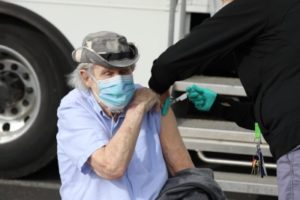
A veteran receives a COVID-19 vaccine at a Cottonwood Community Based Outpatient Clinic event in Arizona. The VA said it is concerned about the number of patients who are eligible but are refusing vaccination. Photo from VA press release
WASHINGTON — The aftermath of the pandemic at VA will require as much emergency funding, if not more, than was required during the actual pandemic, according to VA leadership.
As the vaccine rollout continues and the agency looks to the coming year, VA expects to be glutted with veteran patients who have put off care during the pandemic, as well as those who have lost their employment-connected healthcare and are seeking VA care.
The Biden administration’s $1.9 trillion American Rescue Plan includes more than $17 billion in supplemental funding for VA, which officials say is necessary in order for the agency to weather 2021. That is despite the $10 billion which remains unspent from VA allocations in the CARES Act.
“We’re beginning to recognize very significant unmet needs as veterans come back to us for care,” explained Richard Stone, MD, acting under secretary for health while testifying before the House Appropriations Committee last month. “In recognition for these needs, we have identified substantial additional requirements based on the length of the ongoing fight against the pandemic.”
“Quite honestly, I don’t see how any of us could have seen the impact on America this was going to have,” he added. “We’ve obligated about $6.5 billion of the original CARES Act dollars in FY2020. We’ll obligate the rest of it during this fiscal year. We’ve begun discussing exactly what the long-term effect of this pandemic means to us. We know there’s a huge impact of deferred and delayed care that will begin to come in. We know there’s a huge impact on unemployment. Where people lose their health insurance and come to us as a safety net. We know that there is a huge effect on the modernization of our systems that have been so challenged. We operate a pretty old telephone system in many of the areas of the country. We need to modernize those phone systems.”
Stone also explained that makeshift changes in VA facilities allowing for the creation of additional negative pressure rooms, as well as dedicated areas to treat infectious patients, will need to be made permanent.
“We need to recognize that there might be another pandemic. There may be a variant. And we need to prepare,” he declared.
As for the funding already spent, Stone said that it has made it possible for VA to hire an additional 80,000 employees across the country. VA has also accepted 124 “fourth mission assignments” from the Federal Emergency Management Agency (FEMA), assisting local healthcare systems when they have become overwhelmed.
“In many of these assignments, highly skilled VA staff have volunteered to work alongside the staff of state-run veterans nursing homes, because these facilities were shorthanded or needed specialized training in infection control techniques,” Stone pointed out. “We have also hospitalized 500 critically ill non-veteran civilians in VA facilities in areas of the country where [capacity] has become critically low.”
The department has also made mental healthcare a priority, making it standard to ask patients how they are feeling emotionally, regardless of the context of the interaction.
“This is a huge priority across the country,” emphasized Kameron Matthews, MD, JD, assistant under secretary for health for clinical services. “We’ve made an effort to ensure the mental health screening is not just happening at more traditional intervals, [but] instead with every interaction with the veteran we are asking about their mental health concerns. We know [the potential impact] of the increased isolation and difficulties, even looking at just the economic standpoint from the last year.”
One area where VA has sufficient resources on its end is in its vaccine rollout, Stone testified. The weak link in the system, he said, is in supply.
“We’d like to start vaccinating a broader group of veterans now, but we do not yet have the supply to do that,” Stone explained. “As supply increases, we are ready. VA has built a system of substantial capacity to deliver vaccine well beyond our current supply throughout the country. We are currently delivering virtually all of the doses we receive each week within days of receiving them.”
VA has 9.3 million enrolled veterans with six million being active users of the healthcare system. The CDC and HHS have allocated six million doses for those veterans, as well as 400,000 for employee vaccinations. VA is currently receiving about 140,000 doses a week nationally.
There have been reports of veterans who are not enrolled in VA arriving at VA facilities hoping to get the vaccine. For those who are eligible, VA has been enrolling them immediately.
“Our direction to VISN leadership is to do everything they can to enroll veterans who are eligible on the spot,” Stone said. “Unfortunately, we do not have the supply to reach veterans who are ineligible for care at VA at this time. That has created some very unfortunate circumstances that have troubled all of us.”
Another issue troubling Stone is that some veterans refuse vaccination, including those who are at high risk and currently eligible for the vaccine.
“We understand that there are areas of the country where veterans are not coming in to get their vaccination,” he said. “In one area of New York alone, in a single catchment area, over 1,000 veterans over age 75 said ‘No, thank you.’ That surprised us.”

